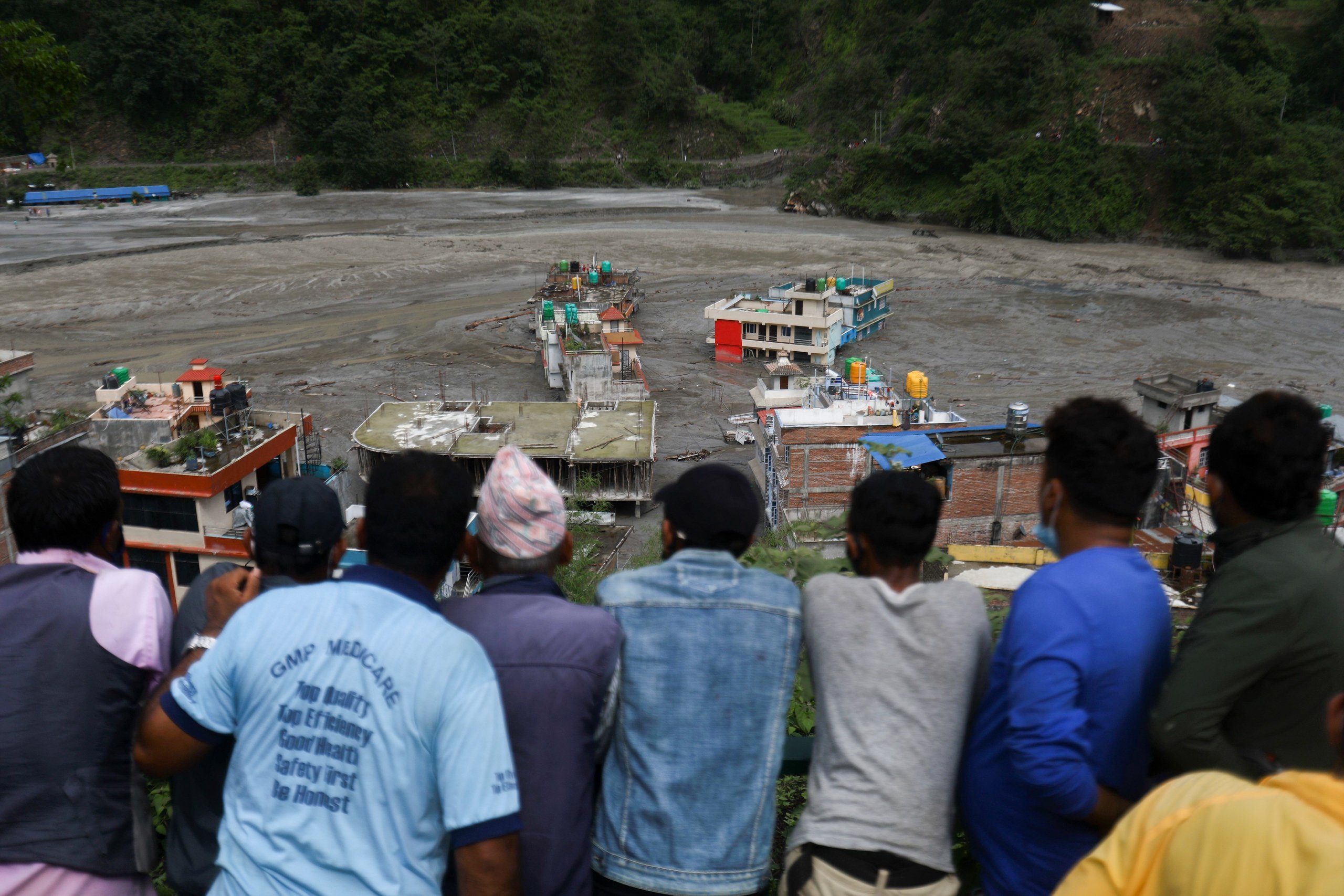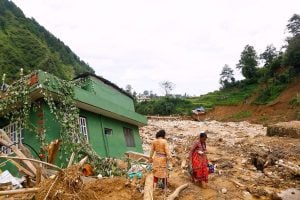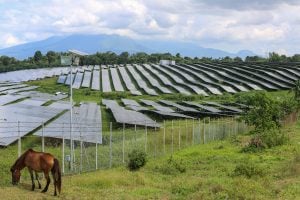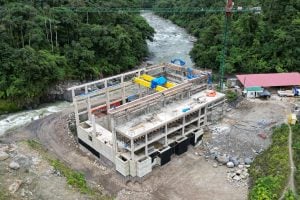Three years after devastating floods damaged the headworks of the Melamchi water supply project, reconstruction efforts are now underway 60km northeast of Nepal’s capital, Kathmandu. Despite the disaster, plans are advancing to divert water from two more rivers, Yangri and Larke, east of the Melamchi River, to supply much-needed drinking water to the city.
Initially proposed in 1997, the project aimed to channel 170 million litres a day (MLD) from the Melamchi basin through a 26.5km tunnel. The Melamchi Water Supply Development Board (MWSDB) was established the following year to address the challenges of “inadequate water supply, increased water demand and poor management of the available water resources.” This was largely due to Kathmandu’s rapidly growing population, which had ballooned from around 150,000 in the 1950s to over 500,000 by 1991, putting immense pressure on the water sources of the metropolitan area.
Former water resources minister Dipak Gyawali explained that “The Melamchi water diversion [project] was just one of the 30 sources of drinking water for Kathmandu Valley, suggested by a 1973 study report.” These included the local rivers of Kathmandu Valley, like the Balkhu and Kodku, the Roshi River in neighbouring Kavre, and snow-fed rivers such as the Sunkoshi and Trishuli.
“But Nepali officials preferred the Melamchi [project], saying it would be easier to acquire land in the area,” Gyawali added.
A history of setbacks
The Asian Development Bank (ADB) initially approved a loan for the project in 2001, with a completion target of 2006. But three co-financiers – the World Bank, the Norwegian Agency for Development Cooperation and the Swedish International Development Cooperation Agency – pulled out after a few years. In 2008, the ADB and the Government of Nepal restructured the project, with the first phase budgeted at USD 317.3 million, with an expected completion date of 2013.
Kathmandu’s population exceeded 2 million, having nearly quadrupled since the project was first conceived
According to the MWSDB website, construction finally began in 2010 but was delayed due to poor contractor performance. In 2012, the contract was terminated and the project resumed in 2014 under a new contractor, Italian company Cooperativa Muratori e Cementisti di Ravenna (CMC). But the 2015 earthquake in Kathmandu compounded the challenges, with more work required of CMC; the disputes that followed between the contractor and the government led to further delays, with the case ending up before an adjudication court. Widespread allegations of corruption further stalled progress, with the government refusing to pay the amount determined by the court, which led to CMC withdrawing in 2018.
In 2019, Chinese contractor Sinohydro took over operations. Despite disruptions caused by the Covid-19 pandemic, the first water from the Melamchi project reached Kathmandu in March 2021. By this time, Kathmandu’s population exceeded 2 million, having nearly quadrupled since the project was first conceived. However, just two months later, a devastating flood, blamed on climate-induced extreme weather, destroyed critical infrastructure, causing NPR 2 billion (USD 15 million) in damages. Research from the Prakriti Resources Center, suggests that the total economic impact of the 2021 Melamchi floods could be as high as USD 500 million.
Recovering from the ruins
Three years on, much of the Melamchi corridor remains buried under debris and huge boulders. Despite ongoing efforts to remove earth near Melamchi Bazaar, the situation remains precarious. Ratna Lamichhane, executive director of MWSDB, told Dialogue Earth that work has already started on a detailed project report for a “robust” new headworks site. This new site would replace the one east of Timbu, where the structures completed in 2021 were subsequently destroyed.
An access road is already under construction leading to the Yangri River, where a future water diversion tunnel will link with Melamchi to the west and the Larke to the east. These would increase the potential of water to be diverted to Kathmandu to 520 MLD. Locals, though, are worried.
“Officials in Kathmandu want to divert water from Yangri and Larke to Kathmandu, but people in this area want proper compensation, safety and security. Floods and landslides have become more common and dangerous,” said Sunita Adhikari, vice chair of Panchpokhari Thangpal rural municipality, which encompasses both the Yangri and Larke rivers. The 2021 floods caused enormous loss and damage in the Melamchi Valley, which destroyed 63 houses, swept away nearly 17 hectares of land, destroyed crops and killed livestock.
Alternatives vs news plans
While efforts to tap alternative water sources located in the southern and eastern outskirts of the valley – such as smaller rivers like Sisneri in Makaowanpur, Thosne in Lalitpur and Mahadevkhola in Bhaktapur – continue, the Nepali government and the ADB remain focused on the Melamchi project. According to Tiresh Prasad Khatri, former executive director of the MWSDB that oversees the project, much of this commitment stems from the substantial sums and time already invested. “Since the government has already spent so much money [NPR 66 billion, or USD 500 million, according to his calculations] and so many years on building the tunnel, water treatment plant, access roads and other infrastructure, the Melamchi [project] remains the most compelling option.” The Melamchi development is one of Nepal’s 21 designated “national pride” infrastructure initiatives, giving it priority status over other development projects.
Mahesh Bhattarai, a retired professor of civil engineering at the Institute of Engineering, Tribhuvan University, argued that “with so much at stake” and a growing population, “the Nepali government has no choice but to go ahead with it”.
He added: “The risks [of climate-induced disasters] are everywhere across the Hindu Kush Himalayas… but the only option Nepal has is to take measures to mitigate these risks, like the 2021 floods, by building back better and stronger.”
Lessons learned?
Lamichhane told Dialogue Earth that MWSDB is waiting for the detailed project report “to rebuild a new Melamchi headworks at a safer site… At the same time, we are working to rebuild, or repair, the access roads and turn them into all-weather roads.”
He hopes to begin the reconstruction as early as 2025, with completion expected by 2028. Simultaneously, he says work will begin to redesign two new tunnels east of Melamchi to channel water from the Yangri and Larke rivers. He emphasised that future headworks would be built inside tunnels to protect them from the kind of damage seen in 2021.
A report found that past designs had failed to address climate risks and that the design flood was exceeded by a factor of 4.5 during the 2021 disaster
An ADB report from November 2023 examined the 2021 Melamchi disaster, attributing it to a combination of excessive rainfall, debris from the 2015 earthquake, glacial lake outburst floods and landslides. “The geomorphological processes that led to the 2021 events, including landslides, sediment deposition and erosion, etc., will continue to occur in the catchment over the foreseeable future,” it warned.
It also found that past designs had failed to address climate risks and that the design flood – the maximum flood level anticipated during the project’s design – was exceeded by a factor of 4.5 during the 2021 disaster. Earlier designs had focused only on rainfall at a time “when climate change was [perceived] a non-issue”.
The report recommended extensive design changes to address the climate challenges and urged the implementation of community safety measures, including a multi-hazard early warning system and a disaster risk management plan, done in consultation with local people. It also called for the “introduction of solutions to reduce landslide risks and offer broad community cost benefits,” as well as the “establishment of an integrated river basin management plan to identify, prioritise and implement local hazard protection solutions at vulnerable sites.” Yet, as construction moves forward, none of these safety measures appear to be in place. But Lamichhane, from MWSDB, told Dialogue Earth “much of that work will be completed before the new phase of construction begins.”
If a similar disaster strikes again, who will be accountable?Ajaya Dixit, water and climate expert at ISET-Nepal
As the reconstruction and new plans to divert water from the Yangri and Larke rivers take shape, concerns mount over the lack of attention to climate risks and community protections. Despite the lessons learned from the 2021 disaster, local residents and experts remain sceptical about whether sufficient precautions are being taken to prevent similar catastrophes in the future.
Ajaya Dixit, a water and climate expert at the Institute for Social and Environmental Transition (ISET-Nepal), summed up the concern: “The challenges and risks inherent in the Melamchi basin are inherent in the Yangri and the Larke basins. And if a similar disaster strikes again, who will be accountable?”









